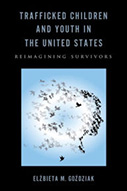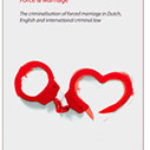Trafficked Children And Youth In The United States: Reimagining Survivors

Author: Elżbieta M. Goździak
Publisher: New Brunswick, NJ: Rutgers University Press, 2016. 182p.
Reviewer: Corinne Schwarz | March 2017
Since the 2000 passage of both the U.S. Trafficking Victims Protection Act and the UN Protocol to Prevent, Suppress and Punish Trafficking in Persons, human trafficking has become increasingly visible in policy, media, advocacy, and research. Even with this current attention, anti-human trafficking efforts have a rich history, tracing back to the “white slavery” panics of the early 20th century. In its past and contemporary forms, the discussion of trafficked youth—primarily youth exploited through commercial sex—has constituted a large part of antitrafficking discourse.
In Trafficked Children and Youth in the United States: Reimagining Survivors, Elżbieta M. Goździak addresses the complicated relationship between stereotypical media depictions of trafficked youth and their lived experiences. Focusing on migrant youth trafficked into the United States, Goździak centers their stories throughout the text. The trafficked youth she interviewed are allowed to speak for themselves, even when their stories complicate the normative narratives of vulnerability, exploitation, and trafficking that shape activism, advocacy, policy, and research. Each survivor presents a different, complex understanding of migration, labor, and kinship, which has important implications for thinking about antitrafficking efforts that do not disempower or further violate migrant youth.
Goździak begins her text with Evelyn’s story, a young Cameroonian woman who was trafficked into the United States by a family acquaintance. Evelyn and her family believed she was coming into the country for school, but instead she was forced into domestic work, and physically and emotionally abused. Goździak describes Evelyn as a “poster child for a trafficked minor,” but her story does not stop after her escape (2). Evelyn received a T-visa, studied homeland security in college, got engaged, and gave birth to a son. She also experienced sexual violence outside of the specific trauma of human trafficking, and still struggles to hold onto a job with her limited networking skills. Escaping her situation of human trafficking did not solve all of Evelyn’s problems by any means. Her life remains complex and complicated after “rescue and recovery,” even though the dominant antitrafficking discourse often tends to paint with a rosy brush the immediate aftermath of escape.
In her introduction, Goździak sets the terms of her research on child trafficking, “juxtapos[ing] programmatic responses—based on the principle of the ‘best interest of the child’—with the young survivors’ perceptions of their experiences and service needs” (5). The concept of “best interest” is not neutral, relying on particular Western notions of childhood and innocence that may not resonate with youth from different backgrounds. Goździak uses the stories from 140 youth, primarily female adolescents and young adults, who experienced exploitation and trafficking before turning 18. Their stories sometimes exist in opposition to those of the service providers with whom they work, who rely upon norms and best practices that may not fully encompass how youth understand and describe their experiences and subsequent needs. Goździak does not discount or discredit these service providers—as mentioned above, she studied programmatic efforts and worked with providers when interviewing child trafficking survivors—but emphasizes that the norms of the social welfare and legal sectors may not fit all youth’s experiences.
Part I addresses the legal definitions, moral ideologies, and historical precedents that currently shape antitrafficking efforts in the United States. Goździak focuses on child trafficking, defined as “the recruitment, transport, harboring, or receipt of children or adolescents (under the age of eighteen) into a situation involving severe exploitation” (23). The force, fraud, or coercion required for adult human trafficking is absent for trafficking of youth—legally, youth cannot ever give consent for certain forms of labor, so long as they are under the age of eighteen. Goździak also draws attention to the complicated way quantitative estimates of trafficking run counter to the relatively small numbers of identified survivors of child trafficking. Human trafficking is hard to quantify, and government agencies and antitrafficking non-profits sometimes rely on proxy measures (poverty, gender equity, or migration) to generate estimates. These numbers mask the complexities of antitrafficking identification and assistance—for example, when trafficked persons are read as smuggled or refuse to cooperate with law enforcement investigations and are thus excluded from services.
In the United States, human trafficking is legislated through the 2000 Trafficking Victims Protection Act (TVPA), which established the “3 Ps” of prevention, protection, and prosecution, and marked “a tenuous alliance between evangelical Christians and secular feminist antitrafficking crusaders” (40). Under subsequent reauthorizations and presidential administrations, the TVPA—and its bureaucratic mechanisms through a variety of government departments—has been used as the primary legal tool to combat trafficking, even though it perpetuates the conceptualization of human trafficking as exclusively sex trafficking. Under the TVPA, migrant youth survivors of trafficking can access services as unaccompanied refugee minors (URMs) through the Office of Refugee Resettlement. Youth are routed to education, housing, health, therapeutic, and legal/visa services and must interact with service providers across all of these sectors. For many of the service providers engaging with youth through URM programs, problems emerged when navigating culturally competent housing and therapeutic services, along with the linguistic and cultural difficulties that emerge in foster care.
Antitrafficking efforts are not neutrally disseminated. Goździak argues that the primary mode of current antitrafficking activism in the United States is shaped by “an extreme (i.e., absolutist, doctrinaire, and unscientific) version of radical feminist theory, which does not distinguish between trafficking for forced prostitution and voluntary migration (legal or undocumented) for sex work” (31). This current framework, which sees all sex workers as victims of sex trafficking, echoes the earlier historical movement against “White Slavery” in the late 1880s and early 1900s. Human trafficking is still primarily framed as violence against women and children through sexual exploitation—it is unquestionably raced, classed, gendered, and sexualized.
Part II complicates perceptions of traffickers that promulgate antitrafficking efforts. The stereotypes of human traffickers as malicious strangers abducting youth for circuits of international crime and exploitation do not appear here. This dominant discourse of human trafficking ignores the fact that, for many migrant youth, the traffickers who bring them into the United States are relatives, partners, and members of their communities at home. Because these are not strangers—and are in many cases members of their kinship networks—the understanding of traffickers as victimizers ignores the nuanced, complex relationship some trafficked youth have with these individuals. Goździak demonstrates the range of experiences youth may encounter while migrating to and working in the United States. For example, Catalina’s parents helped pay the coyote that smuggled her into the country, believing this was the best option for her to gain access to a better life. Flora and Isa’s relatives were arrested and convicted for trafficking, though the girls did not “vilify their mother” or qualify their experiences as exploitative (60). Law enforcement interventions, while fitting with dominant antitrafficking practices, did not always match the justice desired by the migrant youth in Goździak’s study—“even those girls who felt wronged by their loved ones had difficulty conceptualizing their actions as criminal and certainly did not want to see their relatives behind bars” (61).
Older migrant youth who were legally adults in their country of origin frequently struggled with interventions that led to therapeutic services and educational resources. Some wanted to return to work as independent adults; others were mothers with dependent children. In their self-descriptions, these youth were labor migrants exercising their right to work in another country and viewed services that restricted their ability to earn an income as unnecessary or burdensome. Their status as legal minors in the United States trumped any rights they were afforded in their country of origin. Across Goździak’s diverse sample of migrant youth—primarily young women, hailing from various socioeconomic statues and geographies across four continents—misconceptions about youth resiliency, agency, and cultural backgrounds shape their experiences.
In Part III, Goździak addresses the identification of migrant youth and prosecution of identified traffickers. Child trafficking includes both foreign-born youth and citizens, who may have different experiences—and challenges—navigating the various services and institutions that exist to identify and assist trafficked persons. Goździak uses Analisa’s story to highlight the gaps in identification for trafficked migrant youth. Analisa is a young woman trafficked to the United States from Honduras, where she worked alongside her extended family in agricultural labor. After moving from her family’s farm to her father’s home, Analisa’s stepsister Carmen brought her into the United States under the auspices of seeking educational attainment. Because U.S. Customs and Border Patrol did not ask questions of Carmen, who was using fraudulent papers to enter the country, they missed the first opportunity to identify Analisa as being trafficked. Carmen forced Analisa to work in the cleaning service she operated, depriving her of access to school. When neighbors called the police to alert them about this enrollment issue, officers simply told Carmen to enroll Analisa in school, again failing to interrogate their relationship and Analisa’s concerns. Upon her enrolling and briefly attending school, teachers then did not report Analisa’s absences, a third systemic failure. Subsequent encounters with Child Protective Services and border patrol agents failed to generate interventions. Only after Analisa’s stay in an Immigrations and Customs Enforcement detention center—where she was able to work with a pro bono lawyer who had a hunch that her experiences did not warrant deportation but rather human trafficking relief—was she able to start another, equally laborious bureaucratic path to services and assistance.
Even when identification proceeds successfully and traffickers are routed through the criminal justice system, migrant youth face another set of challenges in prosecutions. Human trafficking statistics on prosecutions are generally small or focus instead on the number of T-visas dispensed to cooperative victims—but these statistics fail to account for the resources and emotional labor that must align for prosecutorial success, which often does not match what migrant youth hope to see in terms of criminal justice outcomes. Per the TVPA, survivors under the age of eighteen are not required to testify against their traffickers, but Goździak emphasizes the need to give survivors the final decision. Both pressuring survivors to testify against TVPA rules and denying migrant youth the opportunity to tell their story in a court of law can be damaging.
The book concludes with Part IV, which analyzes programmatic antitrafficking efforts. When service providers offer assistance, they frequently call upon an idealized notion of childhood that may fail to encompass the real needs and lived experiences of their trafficked clients. In particular, this notion of childhood relies upon passivity, negating the agency migrant youth articulate in their description of themselves and their experiences. Goździak emphasizes that agency is nuanced: “Acknowledging that minors—especially older teens—possess agency does not take away from the suffering they experience at the hands of traffickers” (119).
The passivity inherent in the stereotype of child trafficking survivors poses real concerns. For example, the gendered nature of passivity may lead more female youth to be legally interpreted as being trafficked, while male youth may be read as being unaccompanied (criminalized) minors set for deportation, even if the exploitation experienced is the same. Additionally, for older youth with their own dependents or expectations for work, the label of “victim” may be counterproductive to receiving important therapeutic services. Goździak advocates for a more expansive platform of assistance, including “indigenous healing strategies, social justice, or human rights approaches” to address the complex ways migrant youth may wish to access services (133). Additionally, Goździak brings issues of long-term economic stability, language education, and discrimination to the forefront, thinking beyond the immediacy of post-trafficking services.
Trafficked Children and Youth in the United States: Reimagining Survivors thoughtfully asks more of antitrafficking policy, advocacy, activism, and research. By centering trafficked youth’s voices and experiences, Goździak demonstrates the importance of survivor-centered approaches, even when their narratives contradict and complicate current antitrafficking discourse. In particular, by framing trafficked youths as having agency, Goździak implores those engaged in antitrafficking efforts to consider the impact of their services, regardless of their intent. Rather than relying upon tropes that fuel media depictions of trafficking or certain sectors of service provision, Goździak clearly shows the complex reality of migrant youth facing exploitation and trafficking in the United States.
Corinne Schwarz is a PhD candidate in Women, Gender, and Sexuality Studies and a Graduate Research Assistant with the Anti-Slavery and Human Trafficking Initiative (ASHTI) at the University of Kansas.


